Study on Two Types of Stall Patterns in a Centrifugal Compressor with a Wide Vaneless Diffuser
Abstract
1. Introduction
2. Computing Method
2.1. Geometry Model
2.2. Mesh Generation
2.3. Governing Equations and Boundary Conditions
3. Analysis and Results
3.1. Stall Pattern of Vaneless Diffuser with Large Radius Ratio in Centrifugal Compressor
3.1.1. Analysis of Compressor Performance
3.1.2. The Number and Propagation Speed of Stall Cells
3.1.3. Analysis of Stall Frequency Characteristics
3.2. Stall Pattern of Vaneless Diffuser with Small Radius Ratio in Centrifugal Compressor
3.2.1. Analysis of Compressor Performance
3.2.2. Analysis of Stall Frequency Characteristics
3.3. Comparative Analysis of Different Stall Patterns
3.4. Analysis of Stall Mechanism
4. Conclusions
- (1)
- There are two kinds of rotating stall patterns in a centrifugal compressor with a wide vaneless diffuser. For the same backward centrifugal impeller, the number of stall cells does not change, with the flow rate decreasing when the diffuser radius ratio is 1.8, and the circumferential propagation speed of the stall cells presents a development process from low to high. When the radius ratio of the vaneless diffuser is 1.5, the circumferential velocity of the stall cells is larger. The number of stall cells does not change when the radius ratio is 1.5, and the circumferential propagation velocity of stall cells does not develop from low to high.
- (2)
- The stall frequency variations in wide vaneless diffusers with different radius ratios are different. For a long vaneless diffuser with a radius ratio of 1.8, the stall frequency increases gradually with the decrease in the flow rate. For a short vaneless diffuser with a radius ratio of 1.5, the stall frequency hardly changes with the flow rate.
- (3)
- The key factors in stall induction in vaneless diffusers with different radius ratios are the same, but the processes of stall are different. For a wide vaneless diffuser with a centrifugal compressor, the development of the outlet reflux to the interior leads to the distortion of the core flow and induces the rotating stall finally. When the radius ratio of the diffuser is 1.8, it finally forms the “S”-type indirect reflux mode from the inlet to the outlet. When the radius ratio of the diffuser is 1.5, it forms the “1”-type direct reflux from the outlet to the inlet.
- (4)
- Reducing the radius ratio of a vaneless diffuser can increase the stability of the centrifugal compressor. When the radius ratio of a vaneless diffuser is reduced, the stall onset flow rate decreases, and the stable operation margin of the diffuser increases.
Author Contributions
Funding
Conflicts of Interest
References
- Biliotti, D.; Bianchini, A.; Vannini, G.; Belardini, E.; Giachi, M.; Tapinassi, L.; Ferrari, L.; Ferrara, G. Analysis of the rotordynamic response of a centrifugal compressor subject to aerodynamic loads due to rotating stall. ASME J. Turbomach. 2015, 137, 021002. [Google Scholar] [CrossRef]
- Bianchini, A.; Biliotti, D.; Ferrara, G.; Ferrari, L.; Belardini, E.; Giachi, M.; Tapinassi, L.; Vannini, G. A systematic approach to estimate the impact of the aerodynamic force induced by rotating stall in a vaneless diffuser on the rotordynamic behavior of centrifugal compressors. ASME J. Eng. Gas Turbines Power 2013, 135, 112501. [Google Scholar] [CrossRef]
- Zhang, L.; He, R.; Wang, X.; Zhang, Q.; Wang, S. Study on static and dynamic characteristics of an axial fan with abnormal blade under rotating stall conditions. Energy 2019, 170, 305–325. [Google Scholar] [CrossRef]
- Kang, J.X.; Huang, G.P.; Zhu, J.Q.; Wen, D.-Z. Stall mode of centrifugal compressor and mechanism of self-recirculating casing treatment. J. Aerosp. Power 2015, 30, 2960–2969. [Google Scholar]
- Zhang, L.; Zheng, Z.; Zhang, Q.; Zhang, L.; Li, K. Study of Rotating Stall in a Centrifugal Compressor with Wide Vaneless Diffuser. J. Therm. Sci. 2020, 29, 743–752. [Google Scholar] [CrossRef]
- Jansen, W. Rotating Stall in a Radial Vaneless Diffuser. J. Basic Eng. 1964, 86, 750–758. [Google Scholar] [CrossRef]
- Senoo, Y.; Kinoshita, Y.; Ishida, M. Asymmetric Flow in Vaneless Diffusers of Centrifugal Blowers. Trans. Jap. Soc. Mech. Eng. 1977, 43, 987–996. [Google Scholar] [CrossRef][Green Version]
- Senoo, Y.; Kinoshita, Y. Influence of Inlet Flow Conditions and Geometries of Centrifugal Vaneless Diffusers on Critical Flow Angles for Reverse Flow. Trans. ASME J. Fluids Eng. 1977, 99, 98–103. [Google Scholar] [CrossRef]
- Abdelhamid, A.N. Analysis of Rotating Stall in Vaneless Diffusers of Centrifugal Compressors. Can. Aero. Space J. 1980, 26, 118–128. [Google Scholar]
- Tsujimoto, Y.; Yoshida, Y.; Mori, Y. Study of vaneless diffuser rotating stall based on two-dimensional inviscid flow analysis. ASME J. Fluids Eng. 1996, 118, 123–127. [Google Scholar] [CrossRef]
- Dou, H.S.; Mizuki, S. Analys of the Flow in Vaneless Diffuser with Large Width to Radius Ratios. J. Turbomach. 1998, 120, 194–201. [Google Scholar] [CrossRef]
- Ljevar, S.; Lange, H.C.D.; Van Steenhoven, A.A. Two-dimensional rotating stall analysis in a wide vaneless diffuser. Int. J. Rotat. Mach. 2006, 2006, 1–11. [Google Scholar] [CrossRef]
- Shin, Y.H.; Kim, K.H.; Son, B.J. An experimental study on the development of a reverse flow zone in a vaneless diffuser. ASME Int. J. Ser. B Fluids Therm. Eng. 1998, 41, 546–555. [Google Scholar] [CrossRef]
- Abdelhamid, A.N.; Colwill, W.H.; BaIrrows, J.E. Experimental investigation of unsteady phenomena in vaneless radial diffusers. J. Eng. Gas Turb. Power 1979, 101, 52–59. [Google Scholar] [CrossRef]
- Abdelhamid, A.N. Effects of vaneless diffuser geometry on flow instability in centrifugal compression systems. Can. Aero. Space J. 1983, 29, 259–266. [Google Scholar]
- Dazin, A.; Gavazzini, G.; Pavesi, G.; Dupont, P.; Coudert, S.; Ardizzon, G.; Caignaert, G.; Bois, G. High-speed stereoscoipc PIV study of rotating instabilities in a radial vaneless diffuser. Exp. Fluids 2011, 51, 83–93. [Google Scholar] [CrossRef]
- Chu, W.L.; Jiang, T. An Experimental investigation of rotating stall in a centrifugal compressor with vaneless diffuser. J. Aerosp. Power 1990, 5, 163–165. [Google Scholar]
- Shen, F.; Chen, H.; Zhu, X.C. A three-dimensional vaneless diffuser stall model. Proc. Inst. Mech. Eng. Part C J. Mech. Eng. Sci. 2010, 224, 1933–1945. [Google Scholar] [CrossRef]
- Halawa, T.; Alqaradawi, M.; Badr, O.; Gadala, M.S. Numerical Investigation of Rotating Stall in Centrifugal Compressor with Vaned and Vaneless Diffuser. J. Therm. Sci. 2015, 4, 323–333. [Google Scholar] [CrossRef]
- Halawa, T.; AlQaradawi, M.; Badr, O.; Gadala, M.S. Numerical simulation and control of rotating stall in a transonic centrifugal compressor. In Proceedings of the ASME 12th Biennial Conference on Engineering Systems Design and Analysis, Copenhagen, Denmark, 25–27 July 2014; ASME: New York, NY, USA; p. 11. [Google Scholar]
- Zhu, X.C.; Hu, X.C.; Du, Z.H. Formation and suppression of the instability in radial vaneless diffusers. Proc. Inst. Mech. Eng. Part G-J. Aerosp. Eng. 2019, 12, 4606–4622. [Google Scholar] [CrossRef]
- Ötügen, M.V.; So, R.M.C.; Hwang, B.C. Diffuser stall and rotating zones of separated boundary layer. Exp. Fluids 1988, 6, 521–533. [Google Scholar] [CrossRef]
- Grapow, F.; Liskiewicz, G. Three-Dimensional Vaneless Diffuser Rotating Stall Numerical Study; ASME Turbo Expo: Oslo, Norway; ASME: New York, NY, USA, 2018; pp. 11–15. [Google Scholar]
- Zhang, L.; He, R.Y.; Wang, S.L.; Zhang, Q. A Review of Rotating Stall in Vaneless Diffuser of Centrifugal Compressor. J. Therm. Sci. 2020, 29, 323–342. [Google Scholar] [CrossRef]
- Hu, C.; Yang, X.; Zhu, X.; Du, Z. Stability and structural sensitivity analysis of the turbulent flow in the narrow vaneless diffuser with mean flow method. Comput. Fluids 2018, 30, 46–57. [Google Scholar] [CrossRef]
- Zhang, L.; Zhang, L.; Zhang, Q.; Jiang, K.; Tie, Y.; Wang, S. Effects of the second-stage of rotor with single abnormal blade angle on rotating stall of a two-stage variable pitch axial fan. Energies 2018, 11, 3293. [Google Scholar] [CrossRef]
- Menter, F.R. Two-Equation Eddy-Viscosity Turbulence Models for Engineering Applications. AIAA J. 1994, 32, 1598–1605. [Google Scholar] [CrossRef]
- Krain, H.; Hoffmann, W. Verification of an Impeller Design by Laser Measurements and 3D-Viscous Flow Calculations. In Proceedings of the ASME 1989 International Gas Turbine and Aeroengine Congress and Exposition, Toronto, ON, Canada, 4–8 June 1989; ASME: New York, NY, USA; pp. 1–9. [Google Scholar]
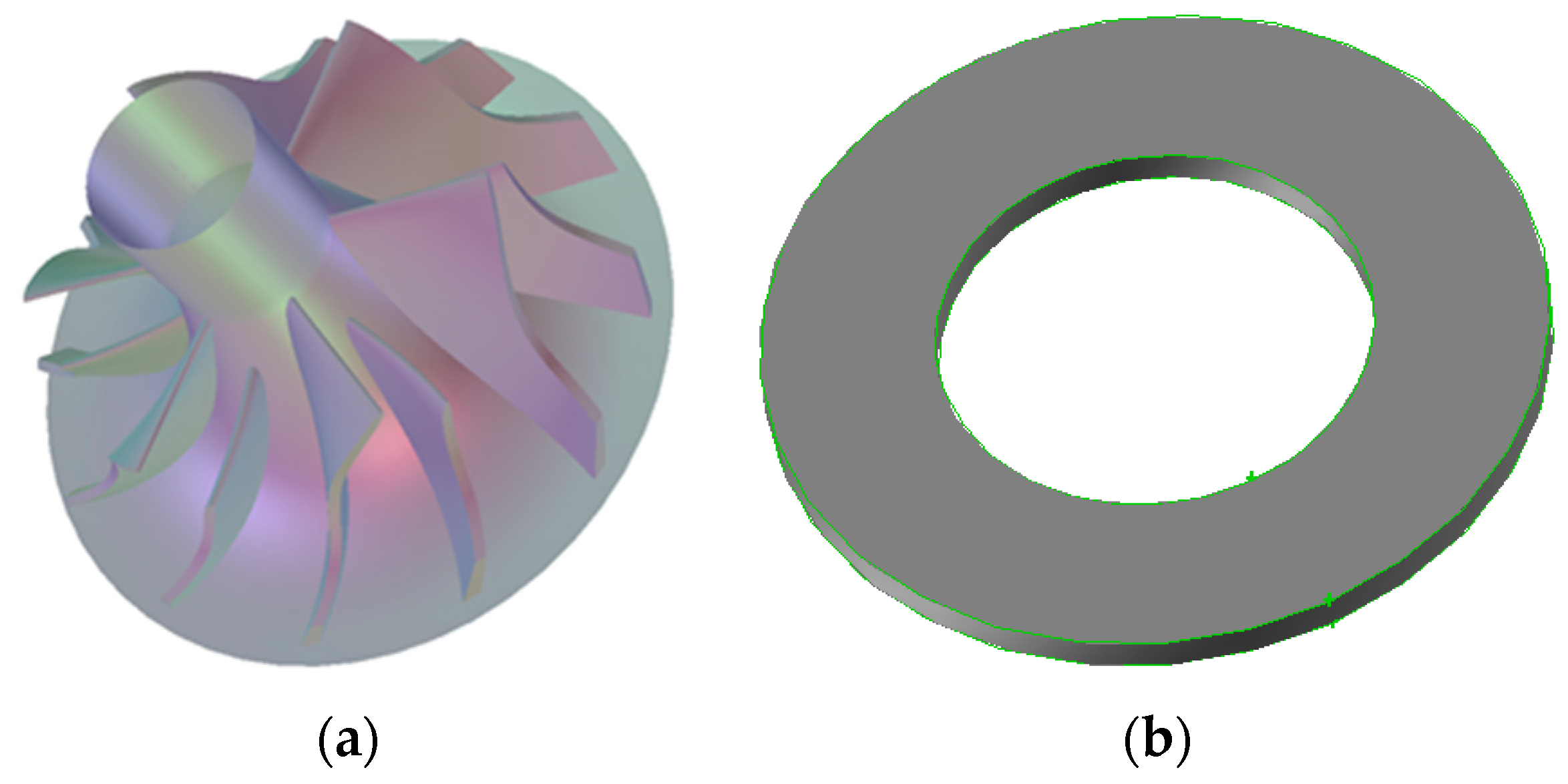
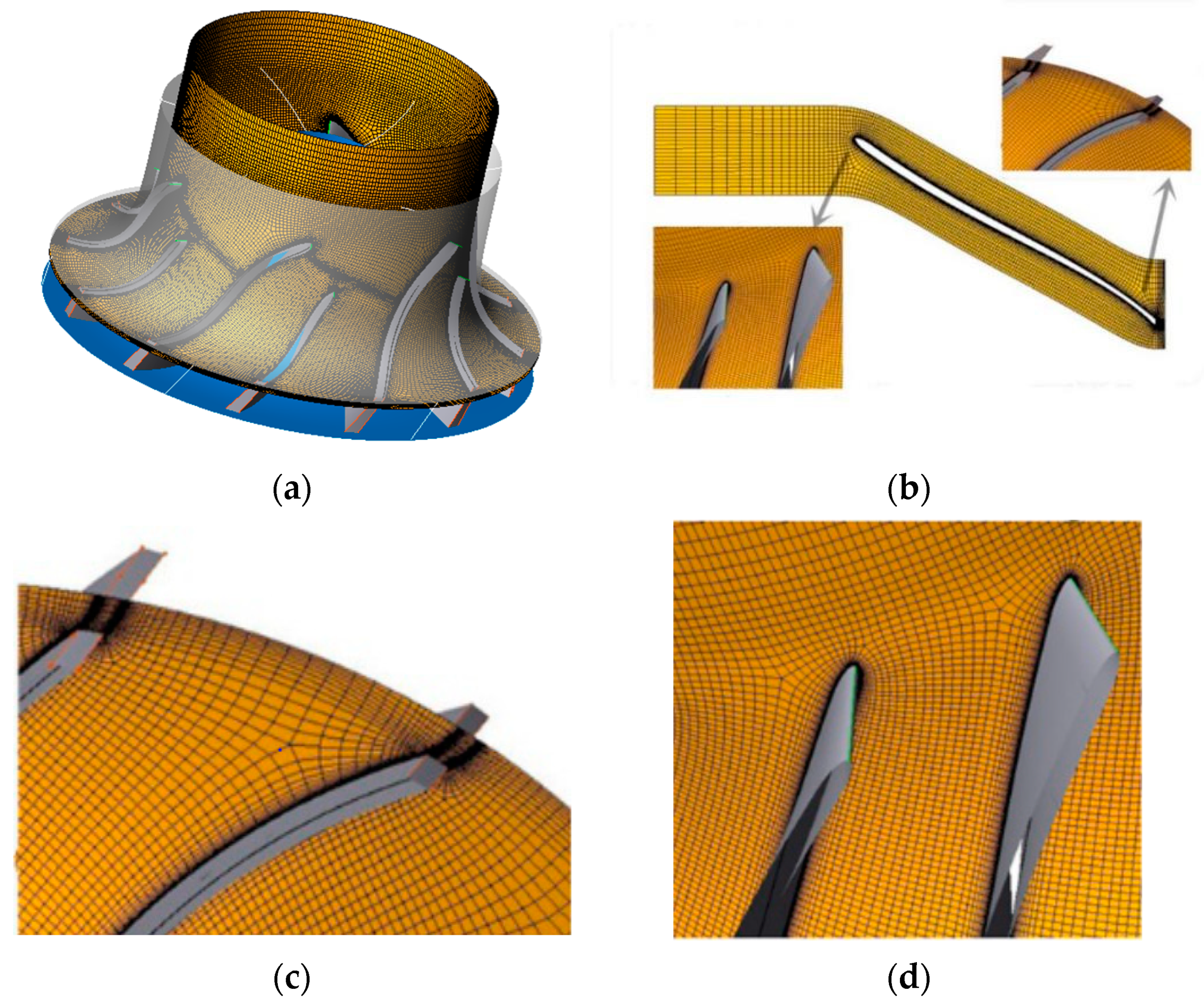
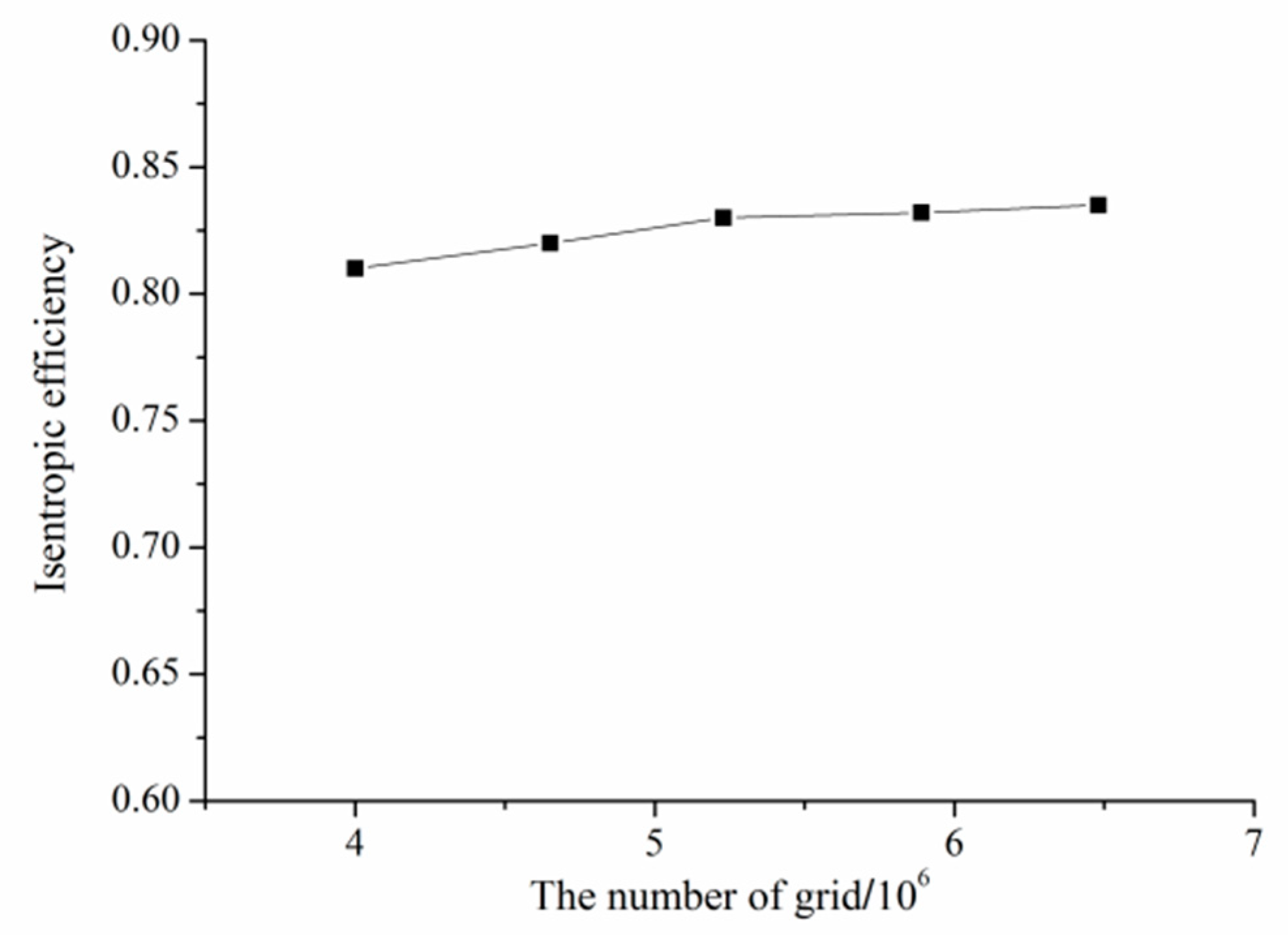
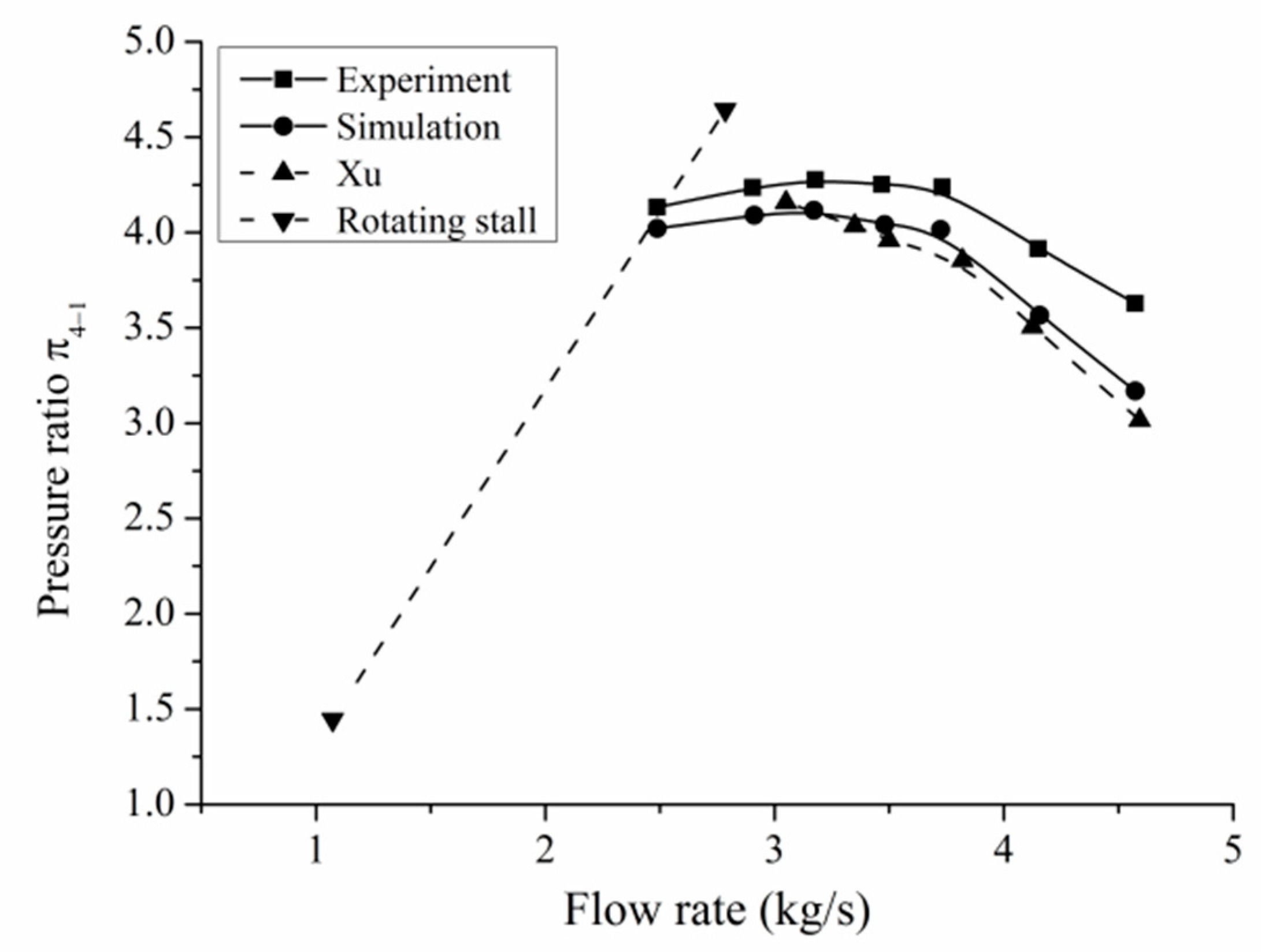


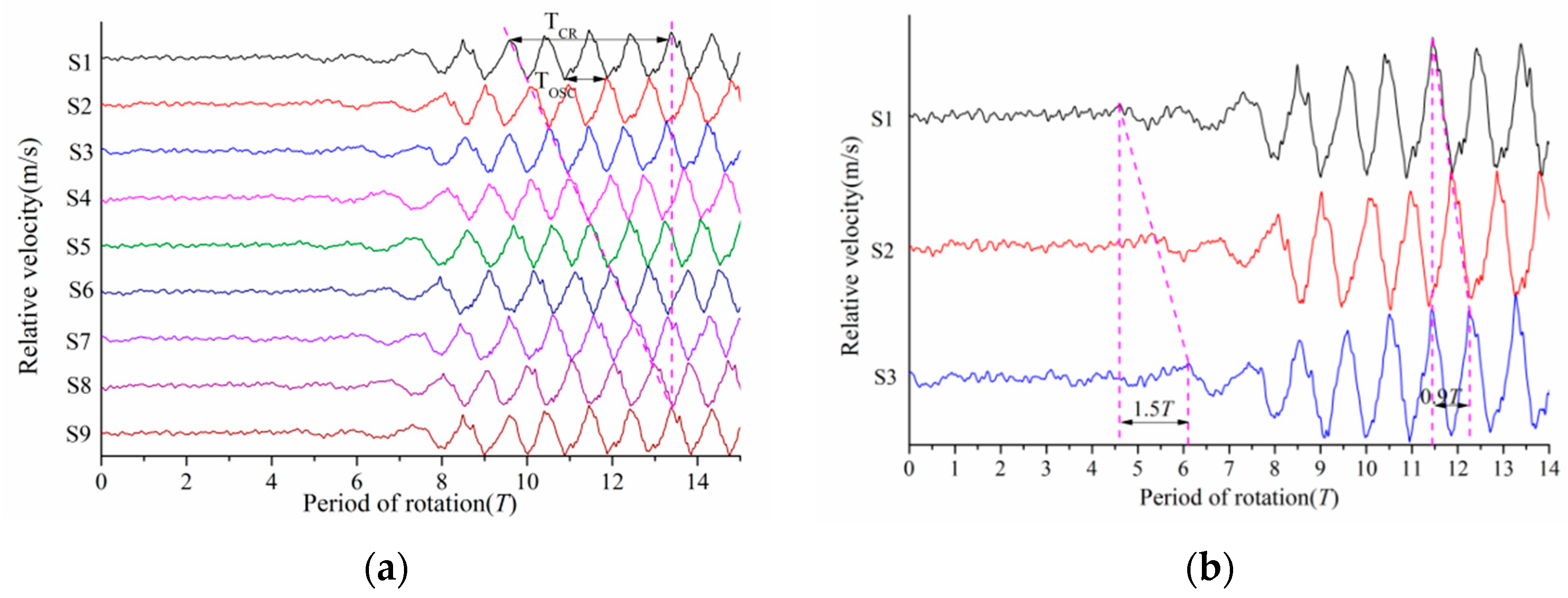
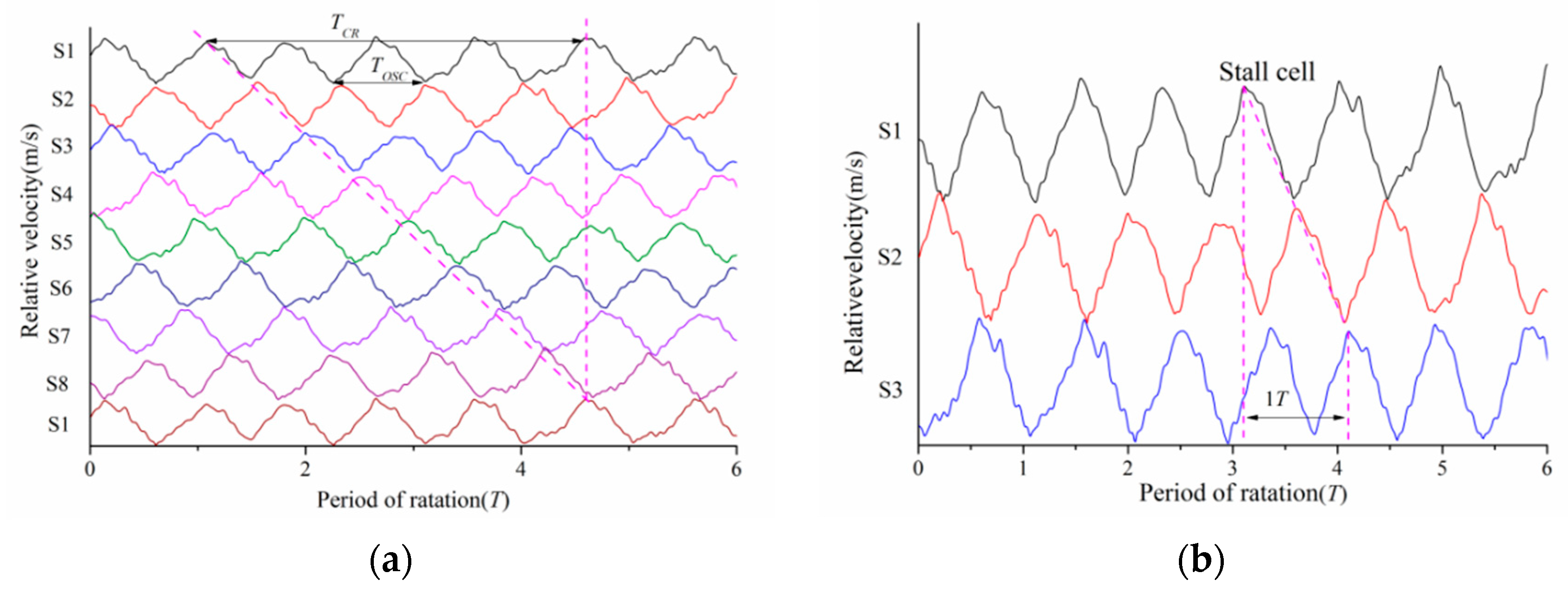
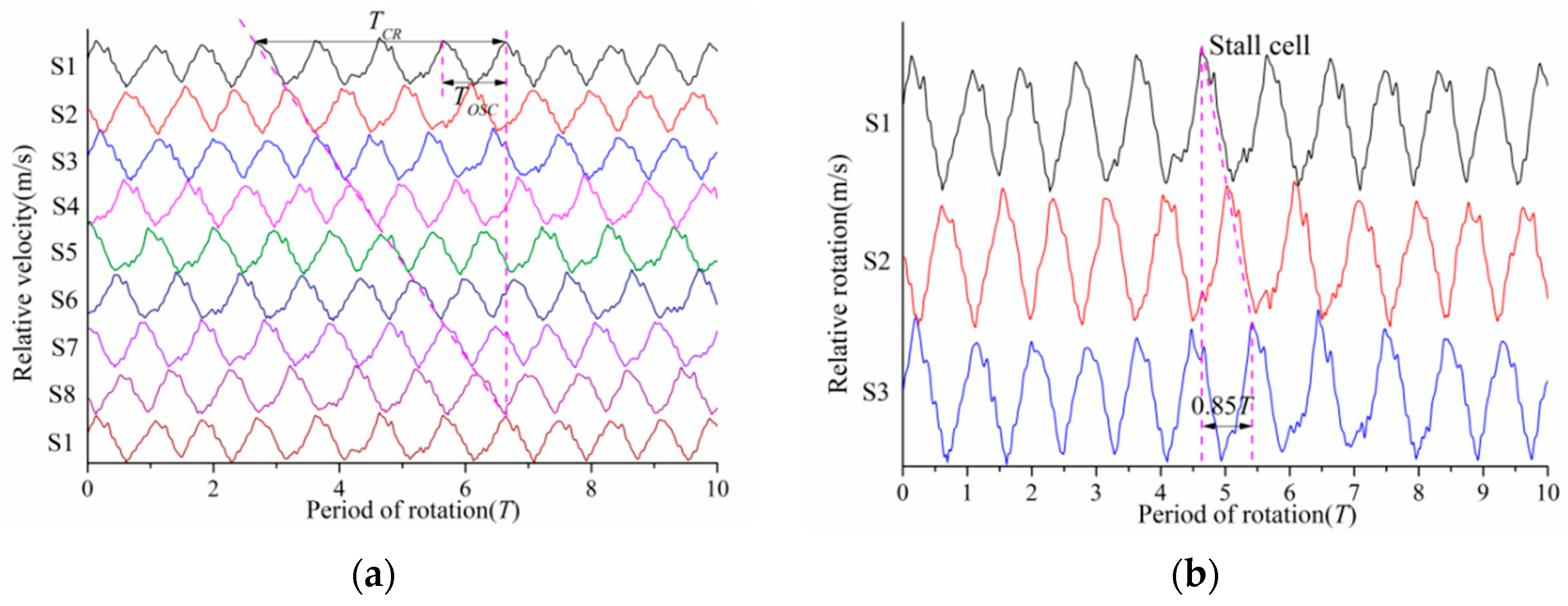
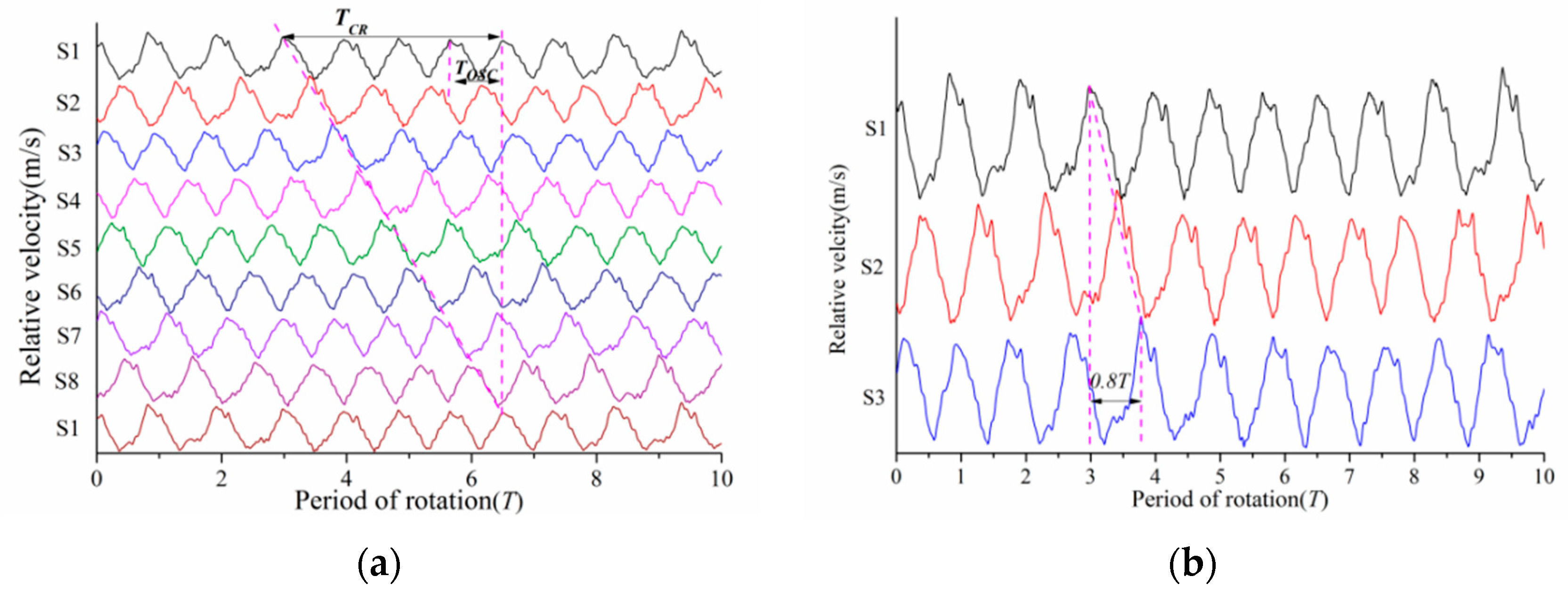
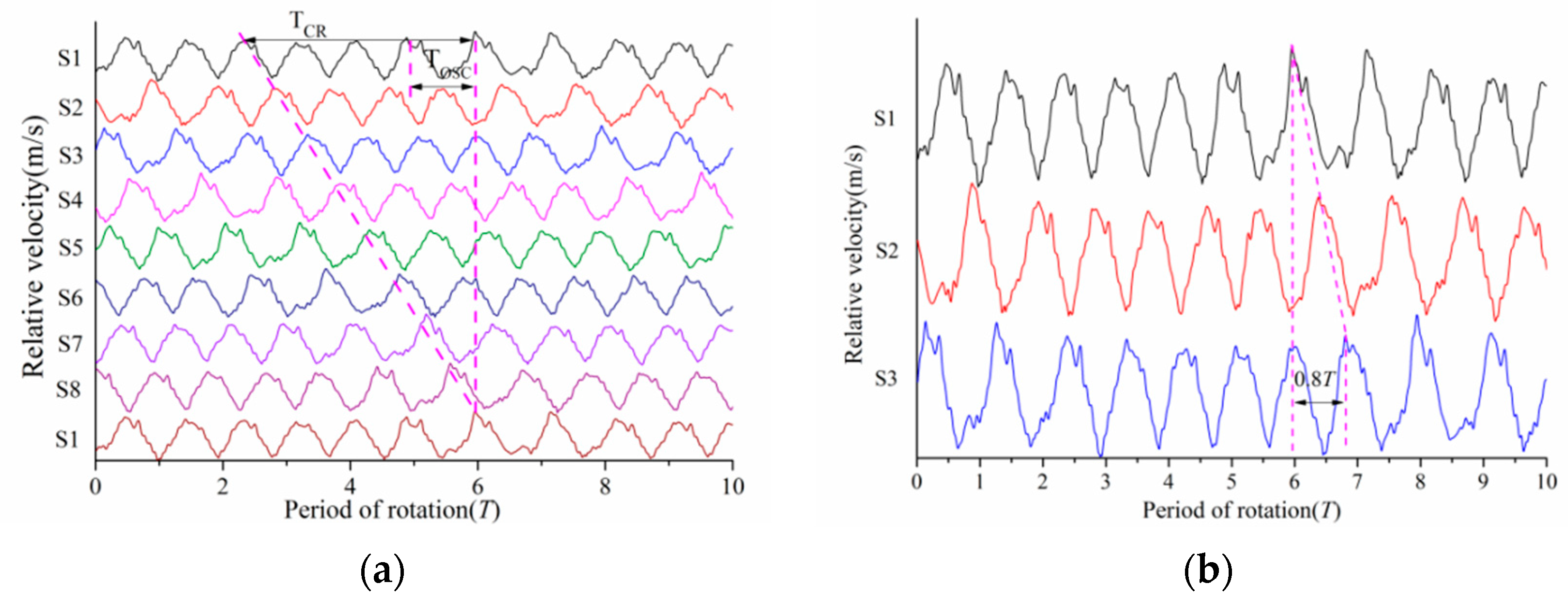
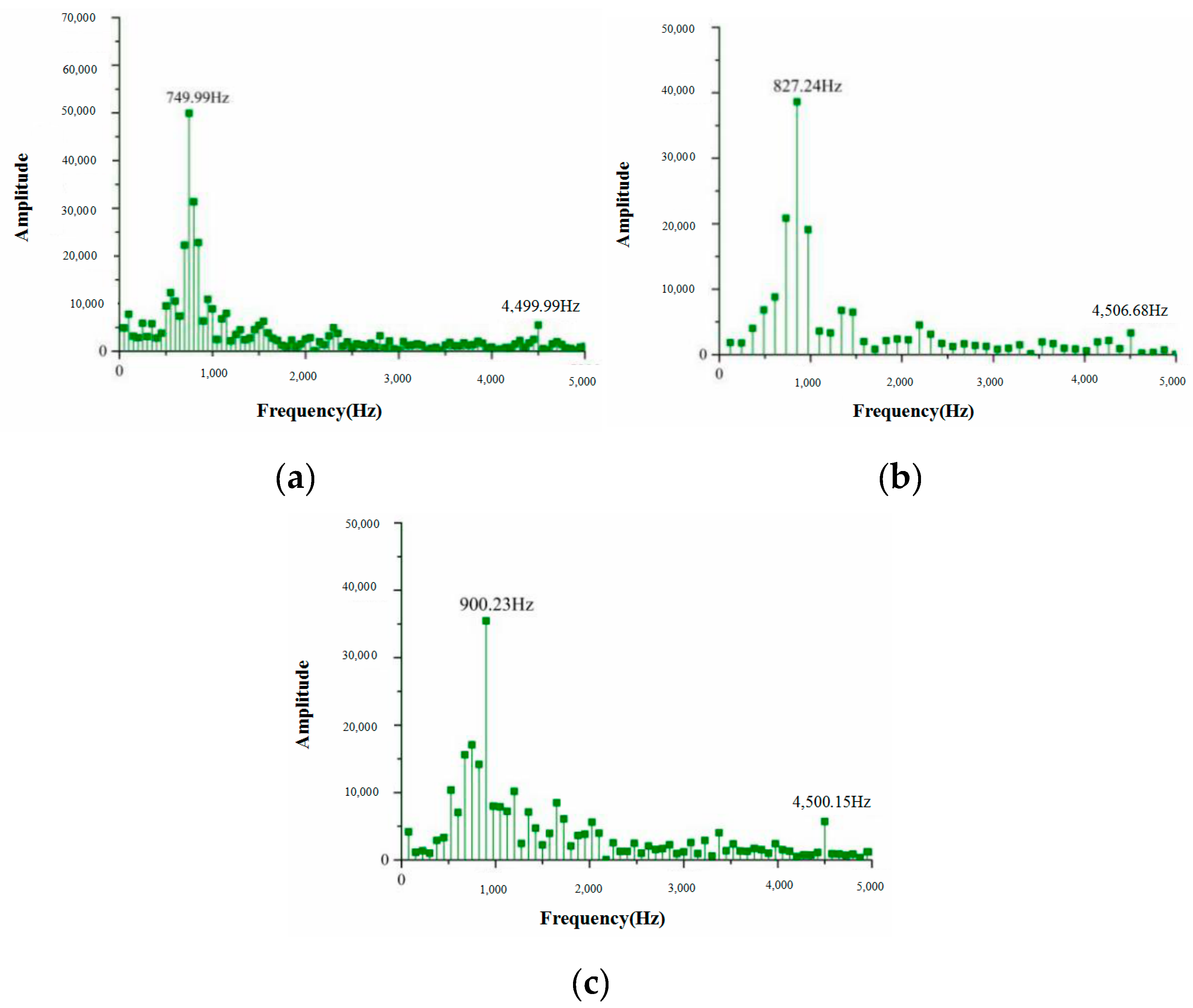

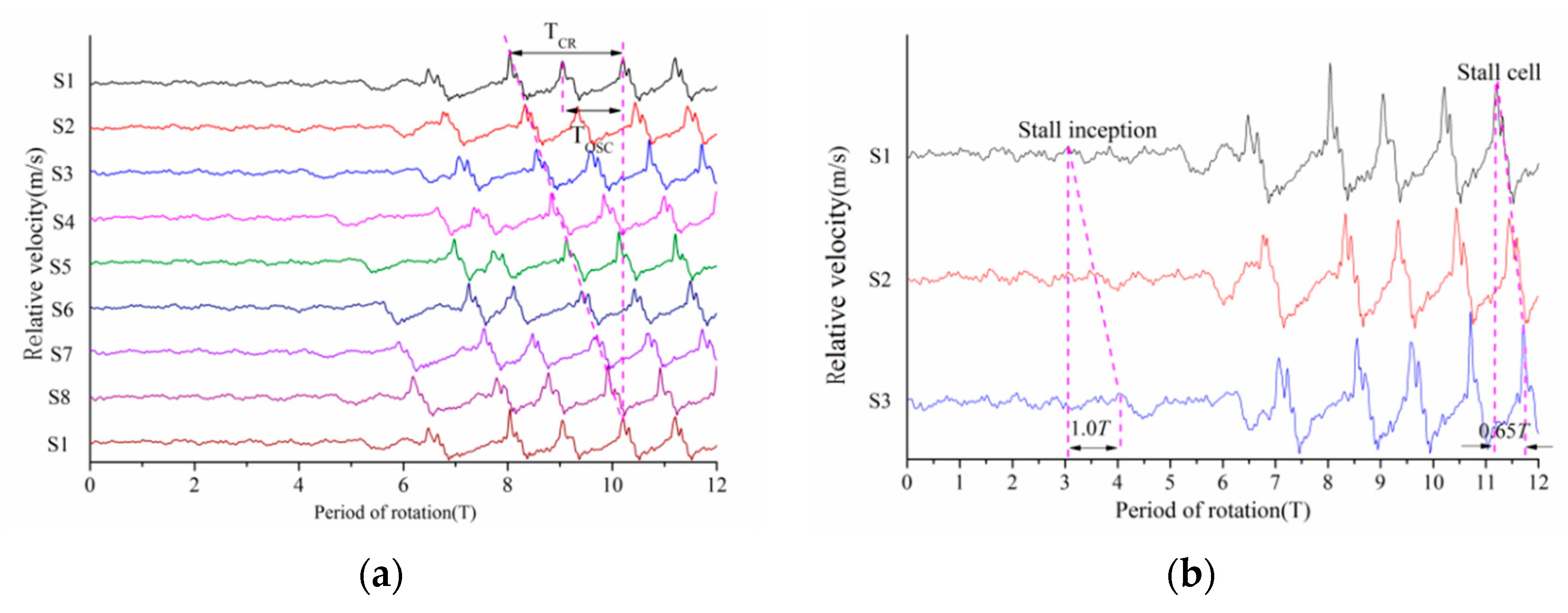
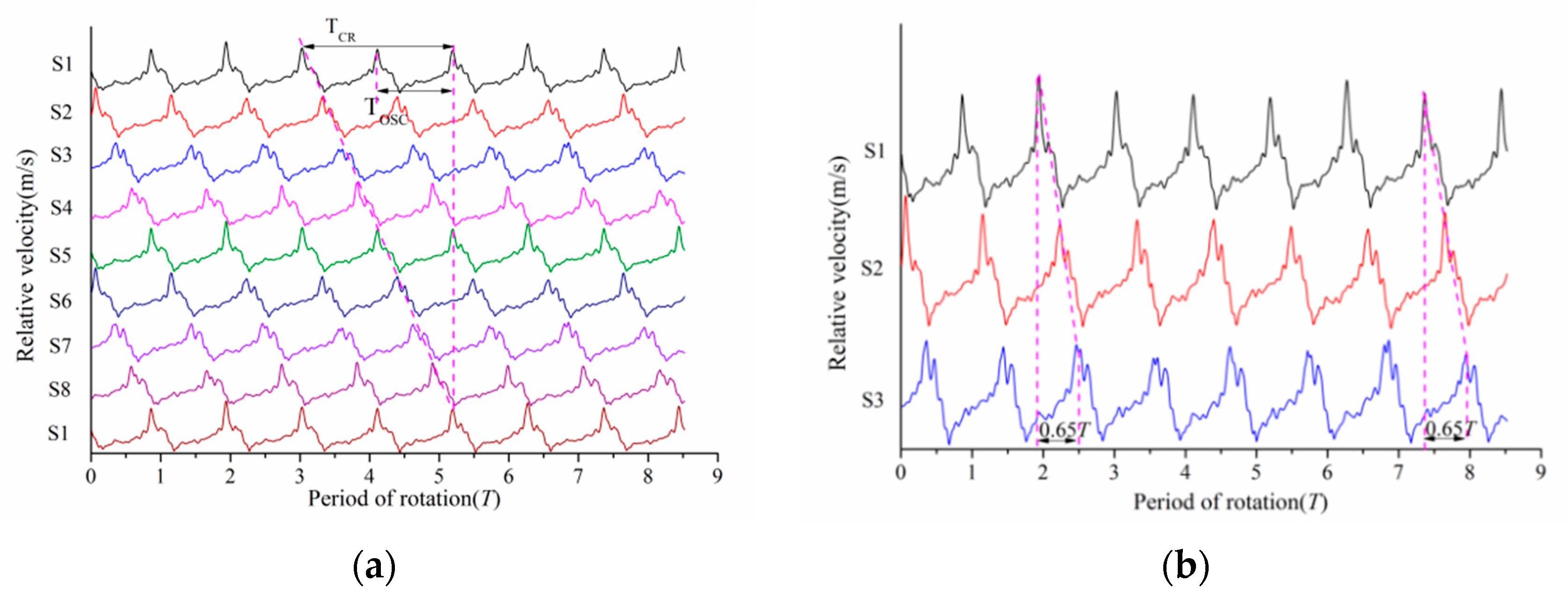
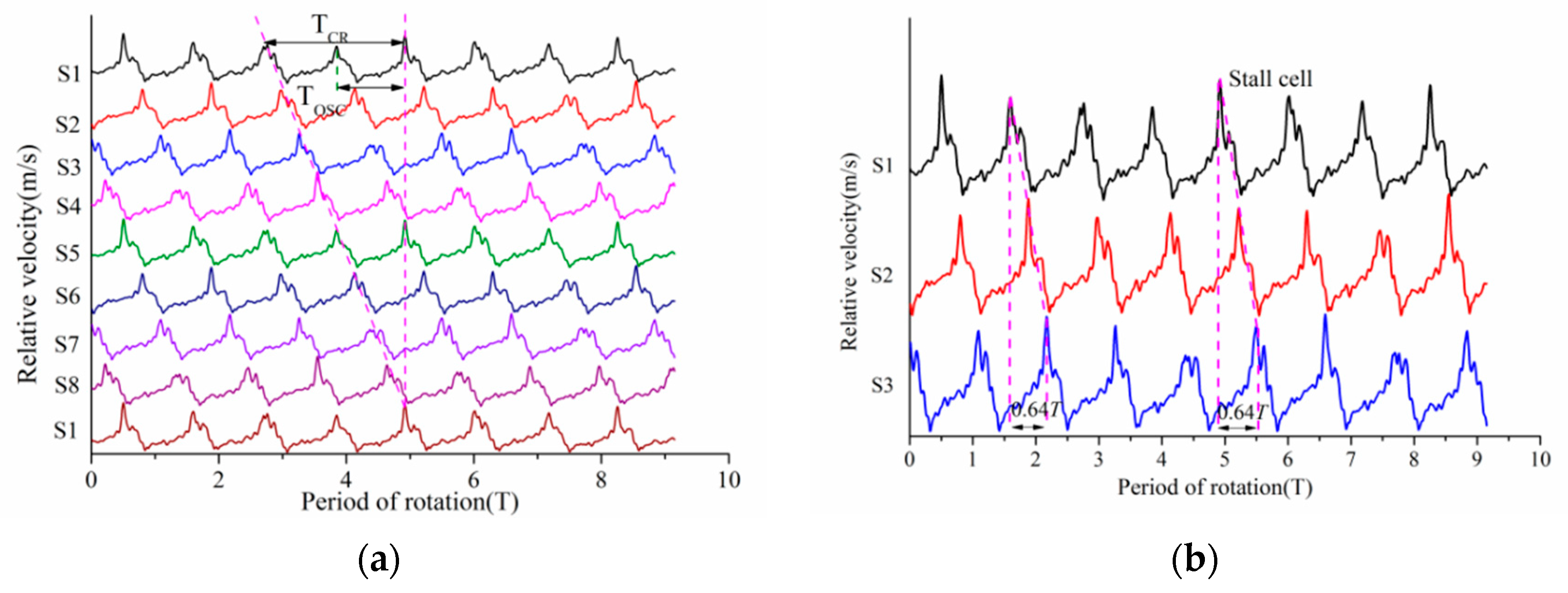
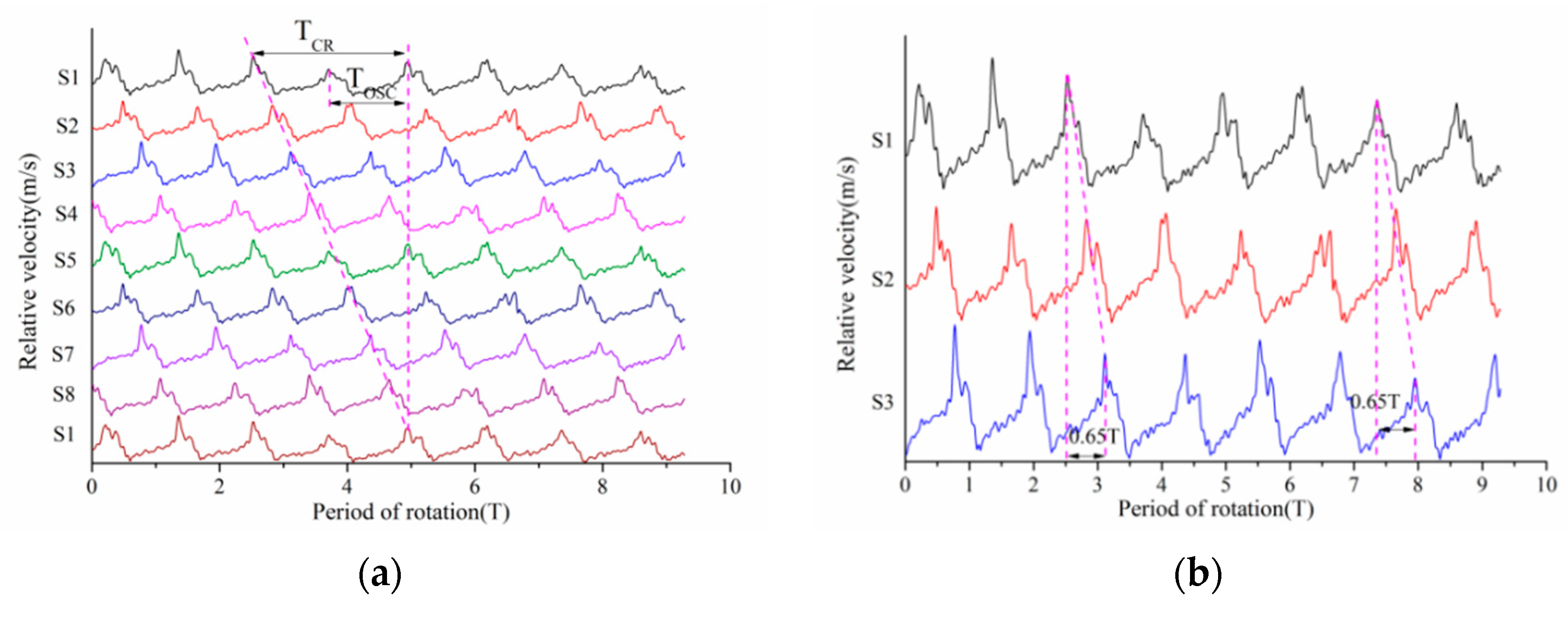
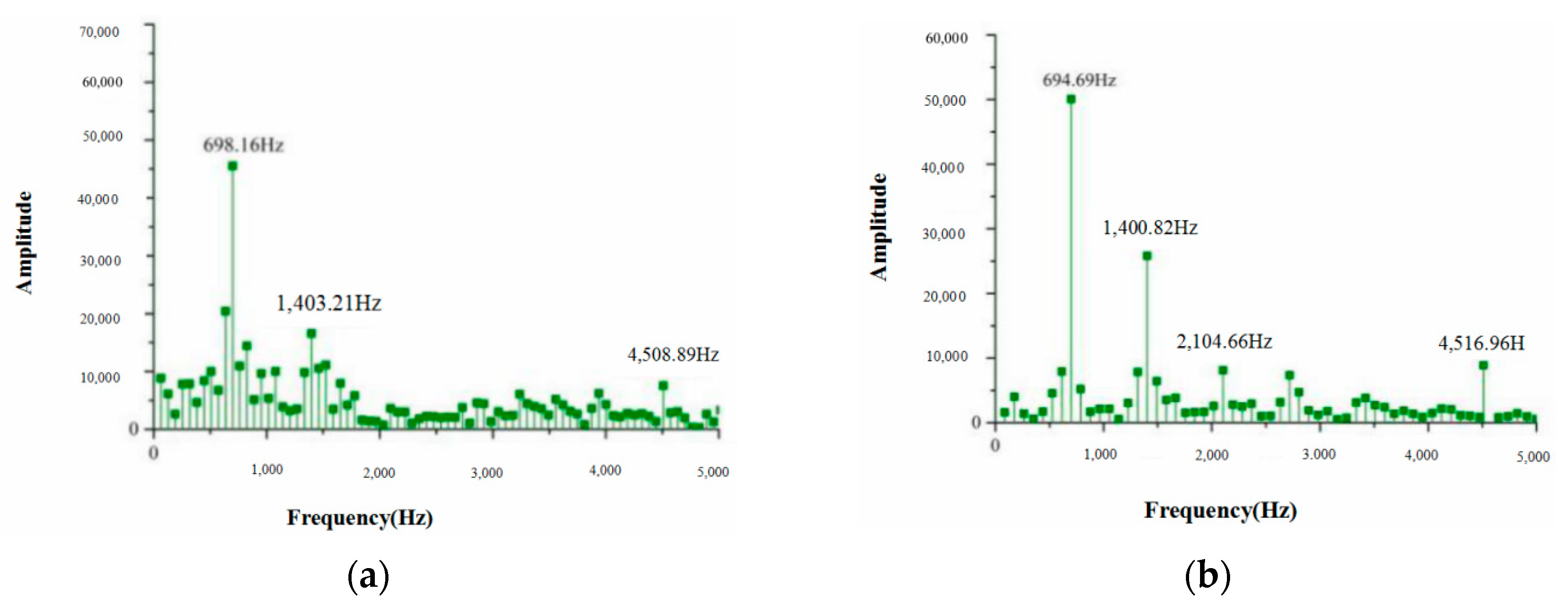

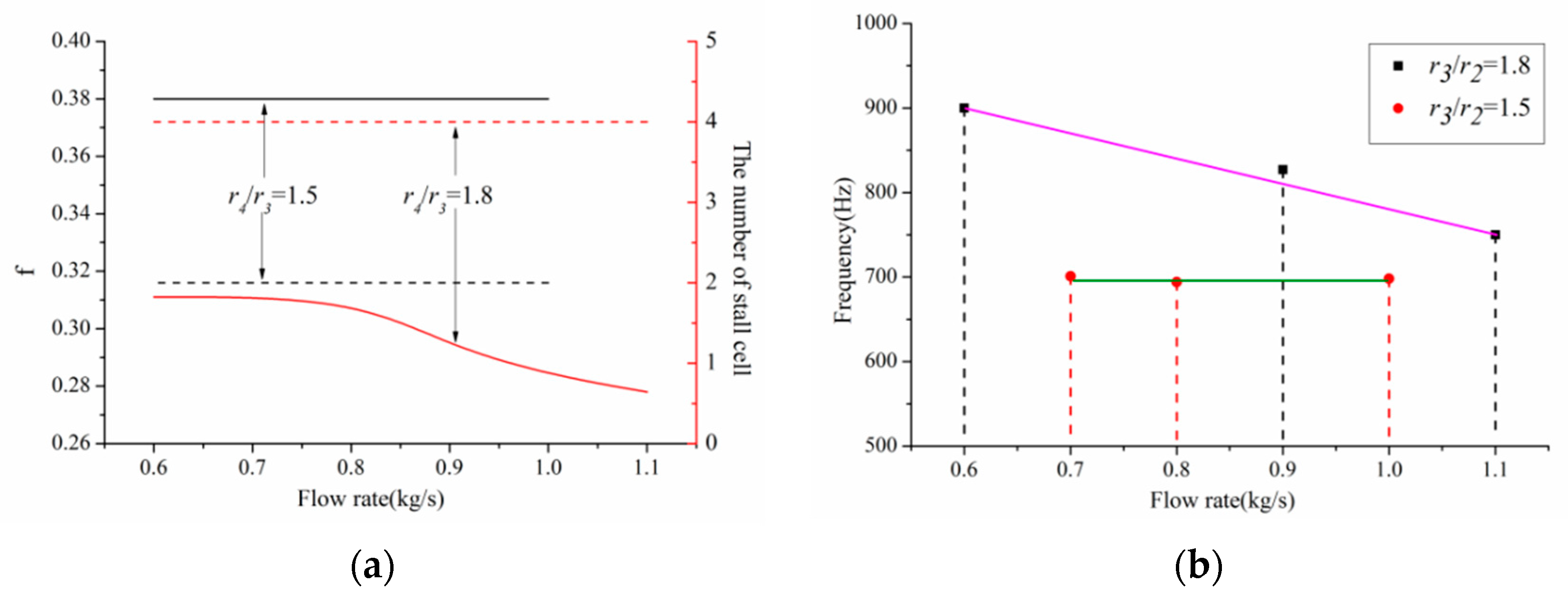
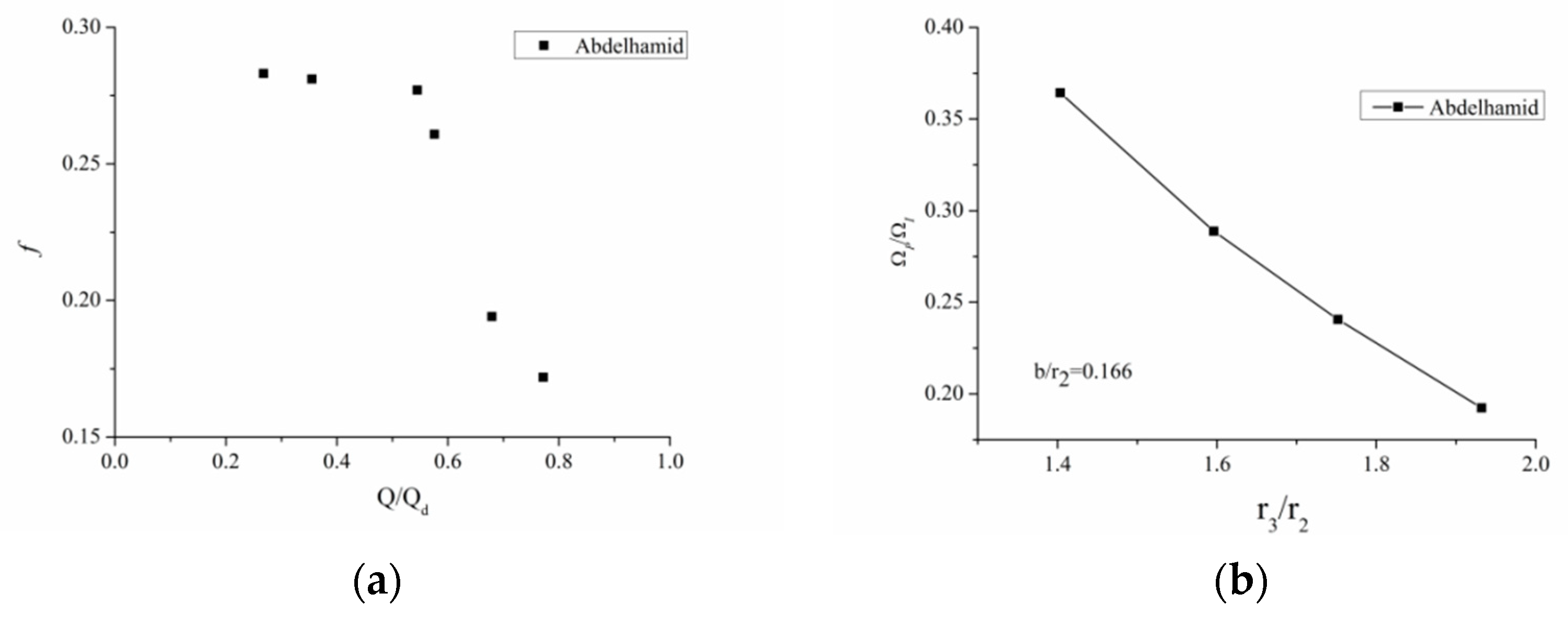

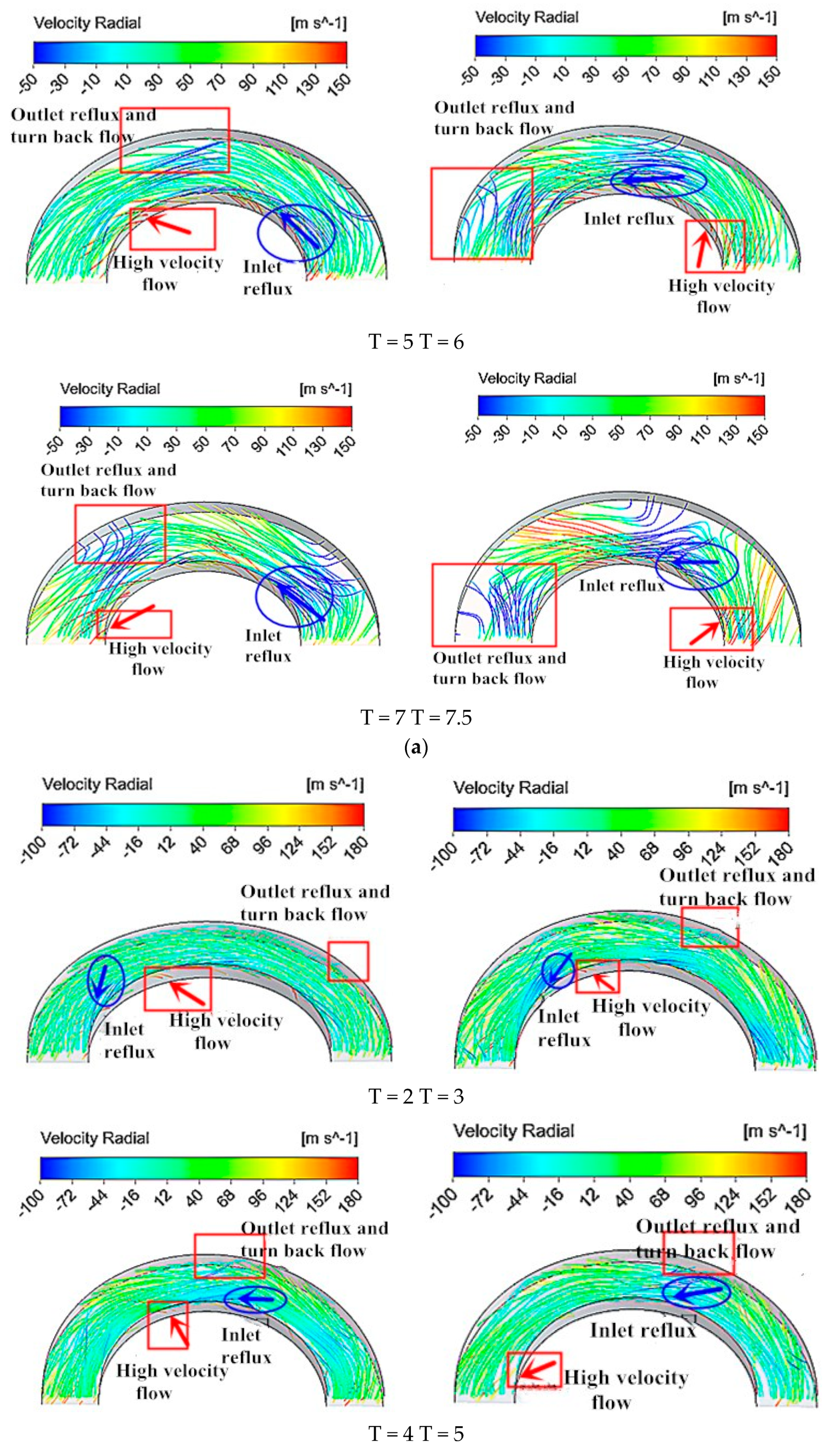

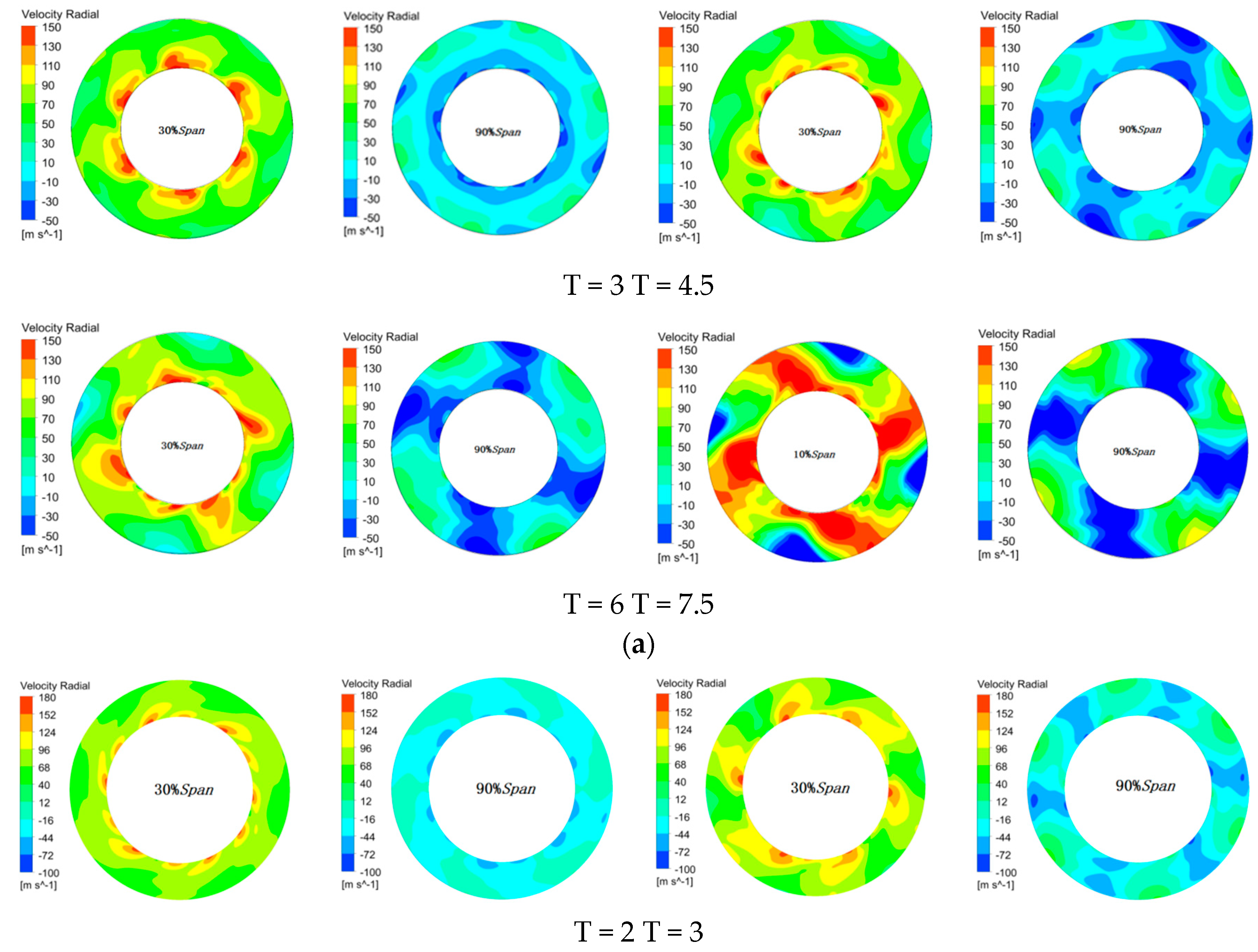



| Parameter | Value | Parameter | Value |
|---|---|---|---|
| Inlet total pressure (pa) | 101,325 | Inlet total temperature (K) | 293.15 |
| Designed flowrate (kg/s) | 2.0 | Designed pressure ratio | 2.5 |
| Designed rotating speed (r/min) | 45,000 | Tip clearance (mm) | 0.3 |
| Hub radius of leading edge (mm) | 25.5 | Tip radius of leading edge (mm) | 40 |
| Impeller outlet radius (mm) | 93 | Relative outlet width of impeller (r2/b2) | 0.1633 |
| Outlet radius of diffuser 1 (mm) | 139.5 | Outlet radius of diffuser 2 (mm) | 167.4 |
© 2020 by the authors. Licensee MDPI, Basel, Switzerland. This article is an open access article distributed under the terms and conditions of the Creative Commons Attribution (CC BY) license (http://creativecommons.org/licenses/by/4.0/).
Share and Cite
Zhang, Q.; Zhang, L.; Huo, Q.; Zhang, L. Study on Two Types of Stall Patterns in a Centrifugal Compressor with a Wide Vaneless Diffuser. Processes 2020, 8, 1251. https://doi.org/10.3390/pr8101251
Zhang Q, Zhang L, Huo Q, Zhang L. Study on Two Types of Stall Patterns in a Centrifugal Compressor with a Wide Vaneless Diffuser. Processes. 2020; 8(10):1251. https://doi.org/10.3390/pr8101251
Chicago/Turabian StyleZhang, Qian, Liang Zhang, Qiuhong Huo, and Lei Zhang. 2020. "Study on Two Types of Stall Patterns in a Centrifugal Compressor with a Wide Vaneless Diffuser" Processes 8, no. 10: 1251. https://doi.org/10.3390/pr8101251
APA StyleZhang, Q., Zhang, L., Huo, Q., & Zhang, L. (2020). Study on Two Types of Stall Patterns in a Centrifugal Compressor with a Wide Vaneless Diffuser. Processes, 8(10), 1251. https://doi.org/10.3390/pr8101251





